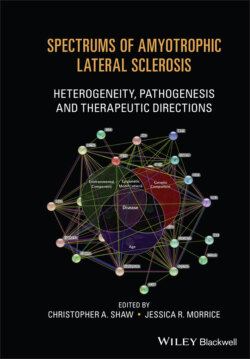Читать книгу Spectrums of Amyotrophic Lateral Sclerosis - Группа авторов - Страница 21
In Vitro Models
ОглавлениеThe combination of in vivo and in vitro models can be a good strategy to investigate disease mechanisms in depth. In recent years, a number of studies have been performed on commercial cells engineered to carry mutations in ALS‐associated genes. In recent years, the innovative possibility of reprogramming somatic cells obtained from patients opened new avenues for ALS research. Hopefully it will lead to significant improvements in the future of regenerative medicine. Generating cells from patients has two significant advantages that are unique in this model:
1 It is possible to obtain human motor neurons, glial cells, and microglia, the cell types that are primarily affected by the disease and that have been studied in the past only as post‐mortem samples.
2 Cells obtained from patients carry exactly the same genetic background as the patient. This means there is no need to insert the genetic mutation artificially: it is possible to study cells as they are in nature. In this context, it is possible to investigate the disease mechanism in all ALS subtypes, including those with known and unknown genetic defects. Moreover, a genetic mutation that arises spontaneously can be corrected using gene‐editing techniques to revert the phenotype.
Two different strategies have been set up to reprogram cells from patients. The most commonly used is the generation of induced pluripotent stem cells (iPSCs) from skin fibroblasts [93] and their subsequent differentiation into motor neurons. The second strategy is the direct conversion of skin fibroblasts into motor neurons or glial cells [94].
Fibroblasts can be easily obtained through a skin biopsy, which is not invasive and is very well tolerated by patients. Specific transcription factors (Oct3/4, Sox2, Klf4, and c‐Myc) can be introduced by retroviral transduction into somatic cells to convert them into iPSCs [93]. To avoid side effects caused by the use of retroviruses that integrate in the genome, various tools have been developed, such as non‐integrating virus and mRNA transcription factors. The iPSCs have the ability to self‐renew in culture and can differentiate into cell types of all three germ layers while maintaining the patient's genetic background. Direct conversion of neuronal cells from fibroblasts allows us to bypass the pluripotent stage and can be obtained by overexpressing a combination of transcription factors [94]. Thanks to this strategy, the maturity of the cell, as well as its epigenetic signatures, are preserved; and stem cells can be a better method to study late‐onset diseases.
Once obtained, iPSCs can be differentiated into every kind of cell. The most recent innovative approach consists of generating three‐dimensional cell cultures called organoids, with the aim of better reproducing intercellular interactions and physiological properties. Organoids are particularly useful for drug testing since they better mimic patient's response and tolerability.
